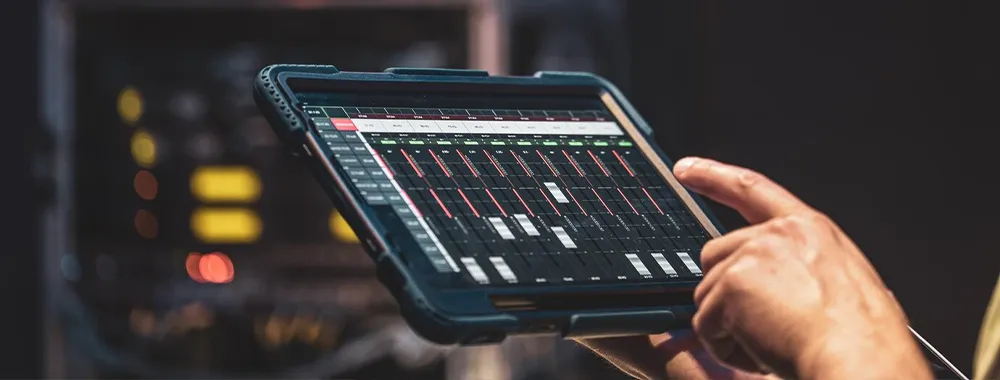IoT for monitoring and predictive maintenance
The Internet of Things (IoT) is radically transforming all industrial maintenance, the way companies manage their plants and machinery, enabling real-time monitoring and failure prediction. Thanks to this technology, machines become “talking” and communicate their health status with almost human precision.
This is the reality that is emerging in the most modern and cutting-edge companies.
The main concern, despite the evidence on the need to adapt to the times, concerns the investments for its implementation, not only in terms of costs but also in terms of staff training.
So what to do?
Embrace change or risk obsolescence? And how to overcome the burden of investments?
That’s why, as a company that produces IoT technology for companies, since 2020 we have been dealing with ready-to-use solutions for the digitalization of industrial machinery for companies and OEMs, creating complete Plug-and-Play solutions that allow you to choose what to monitor, set the most interesting metrics on the fly, receive and analyze data in real time.
How can a small to medium sized business access the IoT technology for monitoring and preventive and predictive maintenance?
The great advantage of these technologies is indisputable, under everyone’s eyes, by now. Through the use of sensors and data analysis we can monitor in real time the operating conditions of industrial machinery, being able to predict failures before they occur and achieving important results:
- reduction of downtime;
- improving efficiency and extending the useful life of equipment;
- reduction in the costs of interventions that would otherwise be necessary.
However, despite all this awareness being now in the public domain, its implementation still poses dilemmas that seem insurmountable: IoT technology requires investment and staff training.
Change, although necessary at a certain point, is often experienced reluctantly, because the entire corporate structure is called upon to change its DNA to adapt to a new technological “life”.
We understand that all of this can be frightening.
But the answer lies in the technology itself which today allows us to bypass obstacles that until a few years ago were insurmountable, because there were no alternatives and because the available solutions were expensive, both in economic terms and in terms of the necessary training.
Today, those who possess the necessary technical skills, knowledge and resources can create technologies that are more accessible and, at the same time, simple and functional.
At this point, and with these assumptions, companies open to change and evolution can improve, indeed literally revolutionize operational quality and productivity.
Predictive maintenance, powered by IoT, is no longer a luxury, but a real and urgent necessity for companies operating in an increasingly “ferocious” market.
IoT Sensors: Tiny Yet Incredibly Powerful for Data Monitoring and Predictive Maintenance
Scattered like silent sentinels throughout the plants, monitored even remotely by a smartphone or tablet app, as well as by PC, IoT sensors are true technological guardians, tireless and vigilant, capable of collecting a mass of data that, until yesterday, would have been unimaginable.
But the real “magic” happens when this data is processed.
It is at this point that sophisticated algorithms peer into the future of machines, predicting failures before they occur, eliminating downtime (the sworn enemy of productivity), keeping them “healthy” and operational well beyond conventional expectations, and allowing huge amounts of money to be saved.
But what are we talking about?
If it wasn’t clear yet, here’s what predictive maintenance is.

What is IoT-based Predictive Maintenance?
IoT-based predictive maintenance uses sensors and smart devices to collect data about the operating conditions of machinery. This data is analyzed to identify patterns and anomalies that may indicate an impending failure.
Key Components of IoT Technology for Predictive Maintenance
To fully understand the potential of this technology, it is essential to know its key components:
- IoT Sensors: they are the eyes and ears of the system that detect parameters such as temperature, vibration, pressure and humidity, providing a constant flow of data on the status of the machines;
- Data communication systems: the data collected by the sensors is transmitted in real time to a central system for analysis. This communication must be fast, reliable and secure.
- Data storage: the collected data is stored in high-capacity storage systems, allowing for historical analysis and the identification of long-term trends;
- Predictive analytics: using machine learning algorithms to analyze real-time data, identifying patterns and anomalies that may indicate an impending failure.
What to Expect from IoT-Based Predictive Maintenance
Reduce downtime
- Early fault detection: IoT sensors continuously monitor operating parameters, allowing anomalies to be identified before they cause failures.
- Predictive analytics:Algorithms analyze data in real time to predict future failures.
Extending the useful life of equipment
- Continuous monitoring:provides a complete view of operating conditions, allowing you to intervene before small problems become serious ones.
- Performance Optimization:adjusting operations to prevent excessive wear.
Cost savings
- Proactive maintenance:prevention of costly repairs and unplanned replacements.
- Resource Optimization:elimination of unnecessary maintenance checks.
Let’s see some concrete examples.
For assembly lines, the use of IoT sensors can be useful to detect early signs of wear.
These sensors can continuously monitor machine conditions and flag any anomalies before they become serious problems.
This type of preventive monitoring helps avoid operational disruptions, costly downtime, and keep production running smoothly.
Even fleet vehicles can benefit from IoT. By monitoring their condition, companies can prevent breakdowns that could disrupt supply chains.
Data collected by sensors can indicate when maintenance is needed, thus reducing the risk of unexpected breakdowns and improving transport reliability.
Finally, machinery in power plants, such as turbines, can be monitored to prevent power outages. IoT sensors installed on turbines can detect variations in performance and flag potential problems before they occur.
This type of proactive monitoring is essential to ensure a continuous and reliable supply of energy.
If you want more examples, in this page you will find all the case studies and areas of application of IoT.

How to Implement IoT-Based Predictive Maintenance
Adopting IoT for predictive maintenance requires a structured approach:
Step 1: Initial Assessment
- Identify critical equipment:Identify critical equipment and select the machines that will benefit most from predictive maintenance.
Step 2: Installing the sensors
- Sensor distribution:Place sensors on critical components to collect relevant data.
Step 3: Data collection and analysis
- Data integration:use a technology suite to centralize data collection and algorithms.
- Real-time analysis:implement algorithms to monitor data and detect anomalies.
Step 4: Maintenance Planning
- Maintenance based on actual operating conditions and no longer on pre-set deadlines.
Step 5: Continuous monitoring and improvement
- Evaluation of results:monitor equipment performance and adapt maintenance strategies based on the results obtained.
How we can help you bring IoT into your business
It is no longer a question of “if” to adopt IoT, but “how” to implement this technology in the most effective way for your business reality.
If you want to know more, contact us to discuss the methodologies and solutions that we can adopt for your business reality.
Logbot was born from the experience of experts in the Internet of Things with the aim of satisfying the increasingly pressing demand for cutting-edge, simple and accessible technological solutions for machine manufacturers and manufacturing companies.
We have chosen an innovative approach, based on simplification and adaptability to different needs. We design and manage tailor-made solutions, allowing companies and manufacturers to optimize production and implement predictive maintenance with a single monthly fee and zero maintenance.
Furthermore, thanks to the IoT plan for Industry 4.0 to 5.0 It becomes even more important in this digital transition driven by Artificial Intelligence, to take advantage of specific incentives for technologies that enable the Internet of Things, cybersecurity monitoring and data management, which offer companies funds that Logbot can help you obtain.

